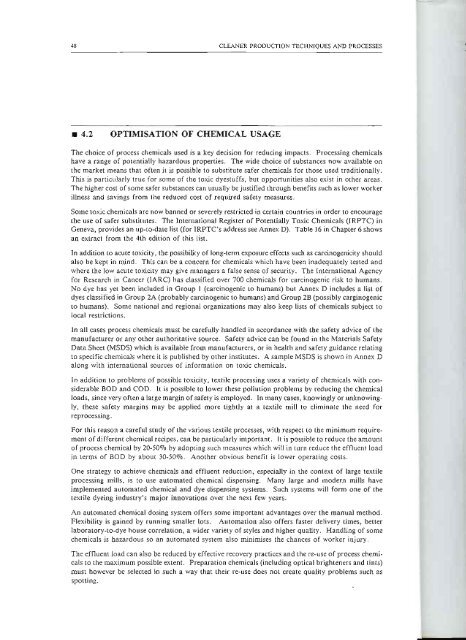Contributor, The Textile Industry and the Environment, UNEP
Contributor, The Textile Industry and the Environment, UNEP
Contributor, The Textile Industry and the Environment, UNEP
Create successful ePaper yourself
Turn your PDF publications into a flip-book with our unique Google optimized e-Paper software.
48 CLEANER PRODUCTION TECHNIQUES AND PROCESSES<br />
.4.2 OPTIMISATION OF CHEMICAL USAGE<br />
<strong>The</strong> choice of process chemicals used is a key decision for reducing impacts. Processing chemicals<br />
have a range of potentially hazardous properties. <strong>The</strong> wide choice of substances now available on<br />
<strong>the</strong> market means that often it is possible to substitute safer chemicals for thost": used traditionally.<br />
This is particularly true for some of (he toxic dyestuffs, but opportunities aJso exist in o<strong>the</strong>r areas.<br />
<strong>The</strong> higher cost ofsome safer substances can usually be justified through benefits such as lower worker<br />
illness <strong>and</strong> savings from <strong>the</strong> reduced cost of required safety measures.<br />
Some toxic chemicals are now banned or severely restricted in certain countries in order to encourage<br />
<strong>the</strong> use of safer substitutes. <strong>The</strong> International Register of Potentially Toxic Chemicals (JRPTC) in<br />
Geneva, provides an up-lO-date list (for IRPTC's address see Annex D). Table 16 in Chapter 6 shows<br />
an extract from <strong>the</strong> 4th edition of this list.<br />
In addition to acute toxicity, <strong>the</strong> possibility of long-term exposure effects such as carcinogenicity should<br />
also be kept in mind. This can be a concern for chemicals which have been inadequately tested <strong>and</strong><br />
where <strong>the</strong> low acute toxicity may give managers a false sense of security. <strong>The</strong> International Agency<br />
for Research in Cancer (lARC) has classified over 700 chemicals for carcinogenic risk to humans.<br />
No dye has yet been included in Group I (carcinogenic to humans) but Annex D includes a list of<br />
dyes classified in Group 2A (probably carcinogenic to humans) <strong>and</strong> Group 2B (possibly carginogenic<br />
to humans). Some national <strong>and</strong> regional organizations may also keep lists of chemicals subject to<br />
local restrictions.<br />
In all cases process chemicals must be carefuJly h<strong>and</strong>led in accordance with <strong>the</strong> safety advice of <strong>the</strong><br />
manufacturer or any o<strong>the</strong>r authoritative source. Safety advice can be found in <strong>the</strong> Materials Safety<br />
Data Sheet (MSDS) which is available from manufacturers, or in health <strong>and</strong> safety guidance relating<br />
to specific chemicals where it is published by o<strong>the</strong>r institutes. A sample MSDS is shown in Annex D<br />
along with international sources of information on toxic chemicals.<br />
In addition to problems of possible toxicity, textile processing uses a variety of chemicals with considerable<br />
BOD <strong>and</strong> COD. It is possible to lower <strong>the</strong>se pollution problems by reducing <strong>the</strong> chemical<br />
loads, since very often a large margin of safety is employed. In many cases, knowingly or unknowing<br />
Iy, <strong>the</strong>se safety margins may be applied more tightly at a textile mill to eliminate <strong>the</strong> need for<br />
reprocessing.<br />
For this reason a careful study of <strong>the</strong> various textile processes, with respect to <strong>the</strong> minimum requirement<br />
of different chemical recipes, can be particularly important. It is possible to reduce <strong>the</strong> amount<br />
of process chemical by 20-50070 by adopting such measures which will in turn reduce <strong>the</strong> effluent load<br />
in terms of BOD by about 30-50010. Ano<strong>the</strong>r obvious benefit is lower operating costs.<br />
One strategy to achieve chemicals <strong>and</strong> effluent reduction, especially in <strong>the</strong> context of large textile<br />
processing mills, is to use automated chemical dispensing. Many large <strong>and</strong> modern mills have<br />
implemented automated chemical <strong>and</strong> dye dispensing systems. Such systems will form one of <strong>the</strong><br />
textile dyeing industry's major innovations over <strong>the</strong> next few years.<br />
An automated chemical dosing system offers some important advantages over <strong>the</strong> manual method.<br />
Flexibility is gained by running smaller lots. Automation also offers faster delivery times, better<br />
laboratory-LO-dye house correlation, a wider variety of styles <strong>and</strong> higher quality. H<strong>and</strong>ling of some<br />
chemicals is hazardous so an automated system also minimises <strong>the</strong> chances of worker injury.<br />
<strong>The</strong> effluent load can also be reduced by effective recovery practices <strong>and</strong> <strong>the</strong> re-use of process chemicals<br />
to <strong>the</strong> maximum possible extent. Preparation chemicals (including optical brighteners <strong>and</strong> tints)<br />
must however be selected in such a way that <strong>the</strong>ir re-use does not create quality problems such as<br />
spotting.

















